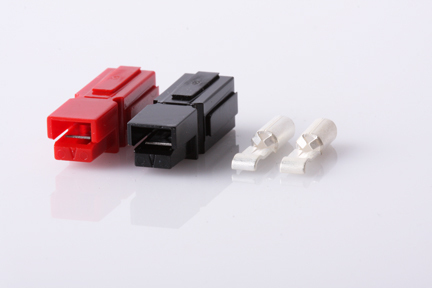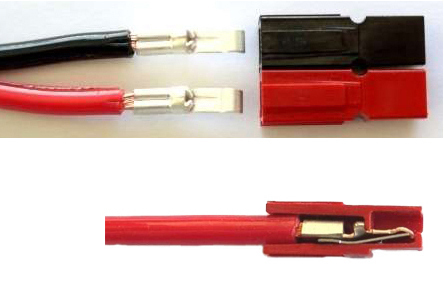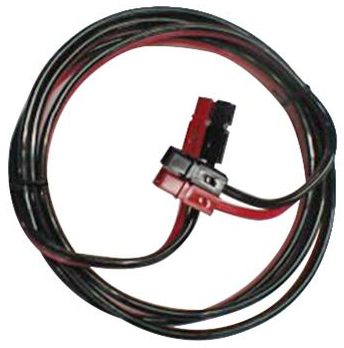One of the really annoying things about ham radio is the sheer number of different cables and connectors out there. With USB alone, there are four or five common ones, and let’s not even talk about all the other connectors for the variety of wall warts.
Reach into your power cord stash and you’ll see a variety of plugs: four- and six-pin, barrel connectors, banana plugs, T-connectors, and many more. It makes you wonder:
Do these manufacturers enjoy the misery they inflict by forcing all these cables and connectors onto the world?
While not a true universal standard, Anderson Powerpoles® are widely considered the go-to connector for 12Vdc power in the ham radio community. They’ve become very popular for connecting radio equipment to power sources like batteries and power supplies. Powerpoles are known for their robust design and secure connections, reliability, ease of use, and the ability to handle both high and low currents.

History of Powerpoles
Anderson Powerpole connectors were developed by Anderson Power Products (APP), a company that has designed and manufactured power connectors for more than 60 years. They have built a reputation for creating more effective electrical connections for a variety of applications, including telecommunications, medical, automotive, and amateur radio.
Up until the year 2000, there was no single standard power connector for 12-volt DC that could handle the many needs of amateur radio operators involved in emergency communications. It was recognized that during an emergency, operators had to quickly hook up and interchange equipment and power cables, but no single standard had been established.
The Powerpole’s genderless, non-polarized format enables you to make a power extension cable taking a black-and-red power zip cord and cutting it into two pieces in the field to make two power pigtails. You can fit them with any connector you need, whether it is for the radio end or the battery end. It doesn’t matter. It’s genderless, meaning you don’t need to worry about male or female ends. Try that with any pair of HF4/JST four-pin connectors.

West Mountain Radio began offering break-out power strips called RIGrunners, which were first available at Dayton Hamvention® in 2001. Other manufacturers have since offered solutions based on the Powerpole.
Ease of Use
The connectors are simple to install. Same-size Powerpoles easily plug into one another without using any adapters. Connectors come in color-coded plastic housings for easy identification. Each color corresponds to a recommended voltage. This color-coding system provides users with a simple way to identify the appropriate connector for their needs, reducing the chance of incorrect connections.
- Yellow (12V)
- Orange (18V)
- Red (24V)
- Gray (36V)
- Blue (48V)
- Green (72V)
- Black (80V)
- Brown (96V)
- Violet (120V)
- White (144V)
One of the most notable features of Anderson Powerpole connectors is their modular design. The connectors consist of a plastic housing that holds one or more metal contacts, typically copper or brass, passing electrical current. The modular nature of the connectors means that users can configure them in various ways depending on their specific needs.

Another feature of Anderson Powerpoles is their reliability and ability to maintain a strong electrical connection even in harsh environments. The connectors are designed to withstand vibration, moisture, and other challenging conditions. This is particularly important in telecommunications and amateur radio applications, where systems are often exposed to extreme temperatures and physical stress.
Powerpoles are also commonly used in automotive (such as recreational vehicle) and marine applications. In these settings, the connectors power devices such as inverters, winches, lighting systems, air compressors, and battery chargers. The connectors can handle the high currents often required for these systems, ensuring a reliable power source for both temporary and permanent installations.
For battery systems used in solar power or backup generators, Powerpoles link batteries together in series or parallel configurations. This modular design allows users to build custom battery banks that meet their specific voltage and current requirements.
Making a Connection
Powerpoles have become the standard because a minimal number of tools and parts are needed to assemble the connectors: wire, housings, contacts, wire stripper, and crimp tool. You can solder them if you want, but it’s much easier and neater to crimp the contact whether assembling at your workbench or in the field.
Editor’s Note: Watch a video from DX Engineering’s YouTube channel on choosing the right tools and techniques to install Powerpoles and check out the DX Engineering Ultra-Grip 2 Crimp Connector Hand Tool Kit.
Most Powerpoles sold by ham retailers come in kits with multiple housings and contacts, usually red (+) and black (-) housings. They slide together to make a single plug, which can be locked in place with a rolled pin in the middle. A small drop of glue will keep the pin in place. Locking retention pins with Powerpole strips can keep the connections in place.
If you don’t need as many outlets as the RIGrunners provide, there are smaller ones that act much like a cube tap to distribute multiple 12Vdc connections. They come as simple splitters and distribution blocks. You can also find ready-made cables for radios and accessories with the Powerpoles already attached.

A Plug for Using Powerpoles
With the rise of amateur radio emergency communications groups like ARES® and RACES, Anderson Powerpoles have eventually become the de facto standard for 12V power connections. Why? The connectors offer a combination of durability, reliability, and ease of use, making them an excellent choice for a variety of applications. It’s nice to have a consistent type of 12Vdc plug available without searching for an adapter.
Icom, Yaesu, and Kenwood still rely on the HF4/JST four-pin and T-connectors for 12V power to their transceivers. But American companies such as Flex and Elecraft are already using Powerpoles to connect their base transceivers to DC power. Power supplies made by Astron, Alinco, and others now include Powerpoles, too.
Whether in amateur radio, automotive, industrial, or marine settings, these connectors provide a secure and efficient solution for powering devices and equipment. Their modular design and flexibility ensure users can easily adapt them to meet their specific needs, making them a go-to solution for hobbyists and professionals.

